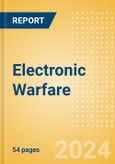The evolution of digitized battlefield technologies such as tactical communications, command-and-control networks, and unmanned platforms has created new challenges and opportunities for EW technology, with the development of novel applications like EW-based Counter-UAS systems or the introduction of advanced EW systems into the space domain providing the impetus for innovation as military forces seek to achieve technological overmatch within the electromagnetic spectrum (EMS). This has driven growth and diversification within the global EW supply chain as both established defense primes and emergent specialist firms look to secure market share over the coming decade.
The global electronic warfare (EW) market has seen a notable spike in growth since 2023 and is currently valued at $16.1 billion in 2024. Following the outbreak of the conflict in Ukraine, the total value of the global EW market jumped from $9 billion in 2022 up to $13.9 billion in 2023 according to the analyst’s historical and current forecasts. While part of this growth can be attributed to the addition of the Space EW segment data, the majority of investments were directed within the Airborne EW and Naval EW segments which saw growth of 64% and 35% respectively between 2022-2023. The value of the EW market is forecasted to grow at a CAGR of 4.6% up to a total market size of $21.8 billion by 2033.
Key Highlights
- Studies of emerging technological trends and their broader impact on the defense market.
- Analysis of the various electronic warfare systems, programs and projects currently under development, as well as the impact of emerging technologies such as artificial intelligence, counter-UAS systems and directed energy weapons systems on the future outlook of the electronic warfare theme.
Who Should Buy
- Our thematic research product, supported by our thematic engine, is aimed at senior (C-Suite) executives in the corporate world, decision makers, and institutional investors.
- Corporations: Helps CEOs, CTOs, and other senior executives of companies understand this key theme, the competitive environment, and the market opportunities.
- Investors: Helps fund managers and other major investors focus on investment opportunities in defense and understand the electronic warfare market.
Scope
- The key defense challenges that forces and defense sector suppliers face are covered.
- The investment opportunities for armed forces, suppliers, and institutional investors, across the whole electronic warfare value chain are covered.
- Highlights from the range different electronic warfare related research and development programs currently being undertaken by various military organizations and defense companies.
Reasons to Buy
- Determine potential investment companies based on trend analysis and market projections.
- Gaining an understanding of the market challenges and opportunities surrounding the electronic warfare theme.
- Understanding how spending on electronic warfare and related segments will fit into the overall market and which spending areas are being prioritized.
Table of Contents
- Executive summary
- Players
- Thematic briefing
- Electronic warfare - understanding the spectrum
- The evolution of EW in 21st-century conflicts
- EW in low-intensity conflicts - minimized risk, minimized investment
- EW in high intensity conflicts - Russian doctrine on Ukrainian battlefields
- Western military efforts to revitalize EW
- Trends
- Technology Trends
- Macroeconomic trends
- Regulatory trends
- Industry analysis
- Market size and growth forecasts
- Case studies
- Timeline
- Signals
- M&A trends
- Venture Financing trends
- Patent trends
- Hiring trends
- Value Chain
- Value Chain - Electronic attack
- Value Chain - Electronic protection
- Value Chain - Electronic warfare support
- Companies
- Leading companies
- Disruptor companies
- Sector Scorecards
- Aerospace, Defense & Security scorecard
- Glossary
- Further reading
- Thematic Research Methodology
- About the Analyst
- Contact the Publisher
- Technology trends
- Macroeconomic trends
- Regulatory trends
- Mergers & acquisitions key transactions
- Key venture financing deals
- Companies: Leading companies
- Companies: Disruptor companies
- Glossary
- Further Reading
- Leading players in the electronic warfare theme
- Visualization diagram of the electromagnetic spectrum and its distinctive bands.
- Electronic warfare in the networked battlespace
- Global electronic warfare market, 2021-2033
- Global EW spending by country, 2021-2033
- Electronic warfare regional spending trends
- Electronic warfare-related M&A activity rebounded strongly post-COVID
- Though 2022 saw a rise in EW-linked venture financing, this trend was not consistent
- Electronic warfare patent trends by company, 2013-2023
- Electronic warfare patent trends, 2013-2023
- Electronic warfare hiring trends by volume, 2020-2023
- Electronic warfare hiring trends, 2020-2023
- Electronic warfare value chain
- Electronic warfare - electronic attack value chain
- Electronic warfare - electronic protection value chain
- Electronic warfare - electronic warfare support value chain
- Sector scorecard - Companies
- Sector scorecard - Thematic
- Sector scorecard - Valuation
- Sector scorecard - Risk
Companies Mentioned (Partial List)
A selection of companies mentioned in this report includes, but is not limited to:
- BAE Systems
- Boeing
- Cohort
- Elbit Systems
- Israel Aerospace Industries
- L3Harris Technologies
- Leonardo
- Lockheed Martin
- Northrop Grumman
- RTX Corp
- Saab
- Rostec Corp
- Spectrum Control
- Teledyne Technologies
- Thales
- Textron
- Alaire Technologies
- Arralis
- Aselsan
- Bharat Electronics
- Cobham
- ELT Group
- General Dynamics
- Hensoldt
- Indra Sistemas
- JSC Concern Sozvezdie
- Larsen & Toubro
- Sierra Nevada Corp
- Sigma Defense Systems
- Terma
- Ultra Electronics
- Unseen Labs








